Charles E W Bean, Diaries, AWM38 3DRL 606/273/1 - 1918 - 1937 - Part 14
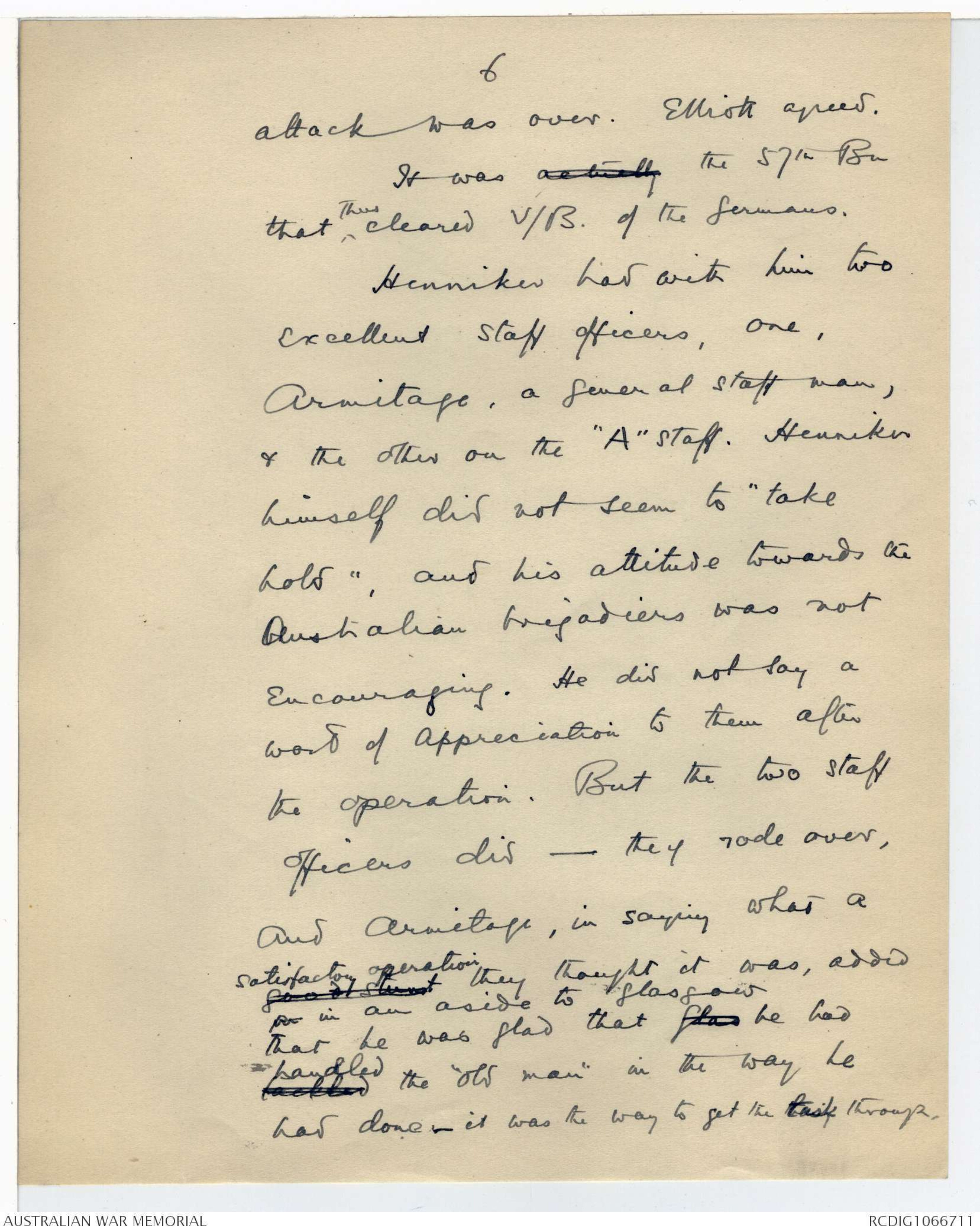

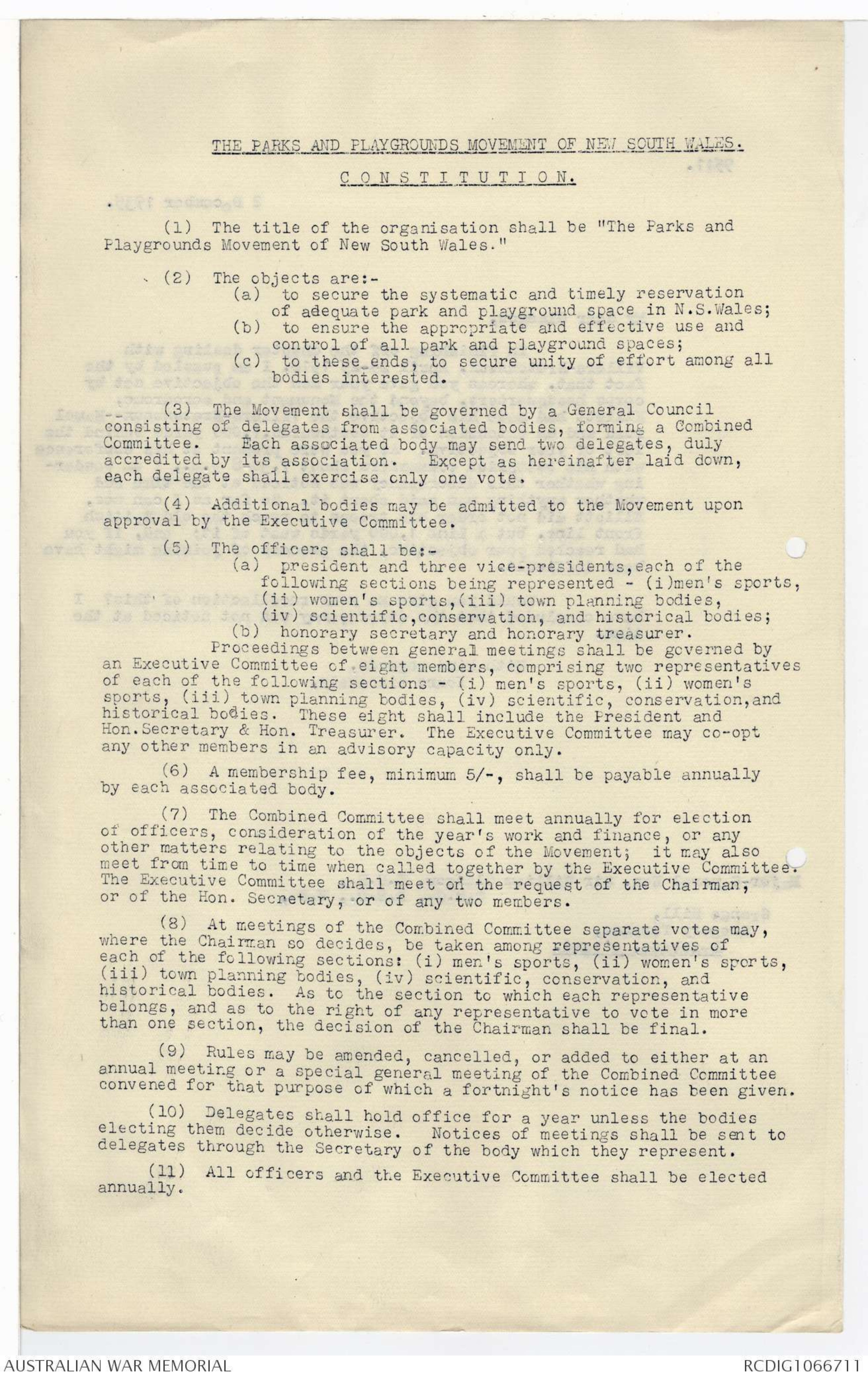
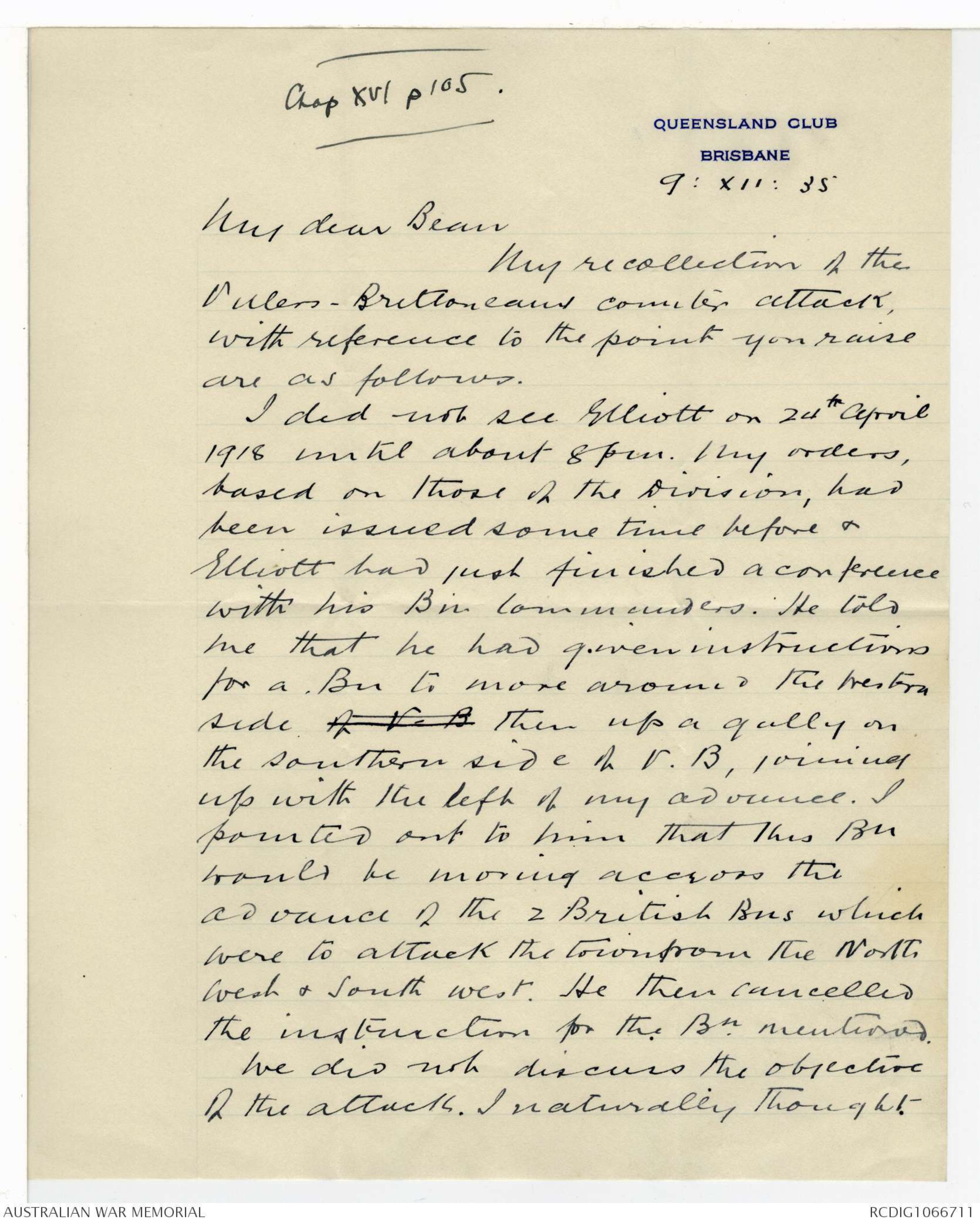

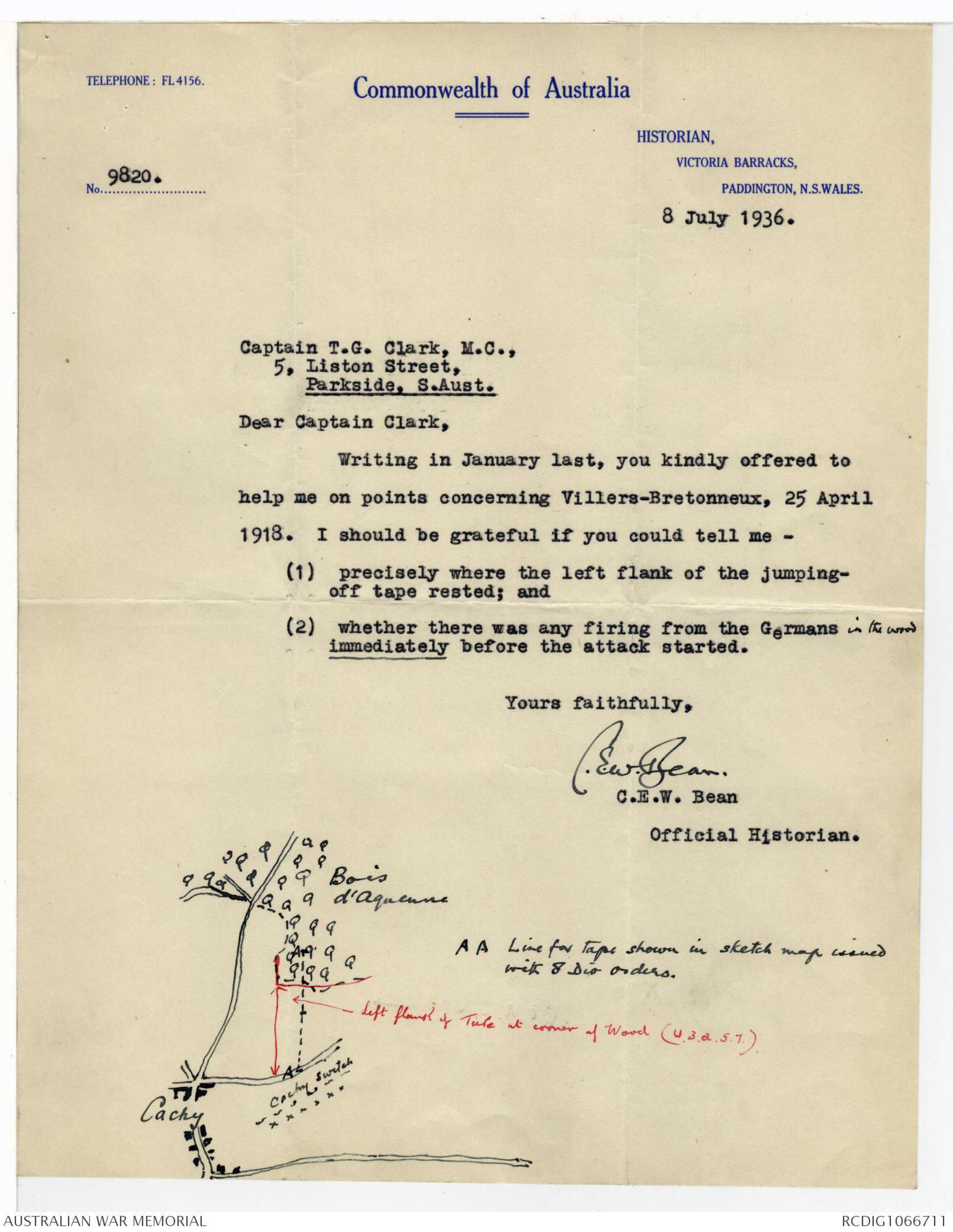
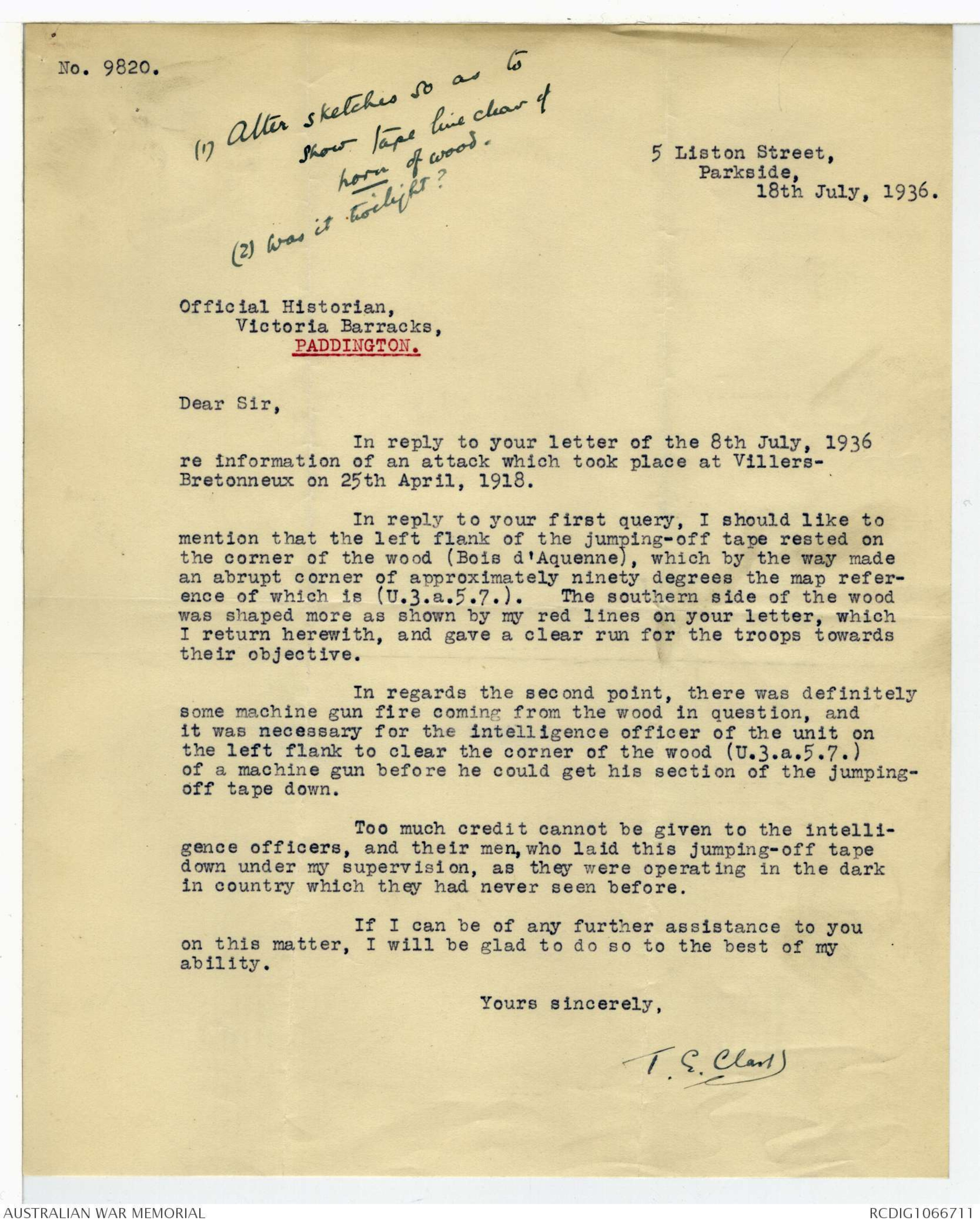
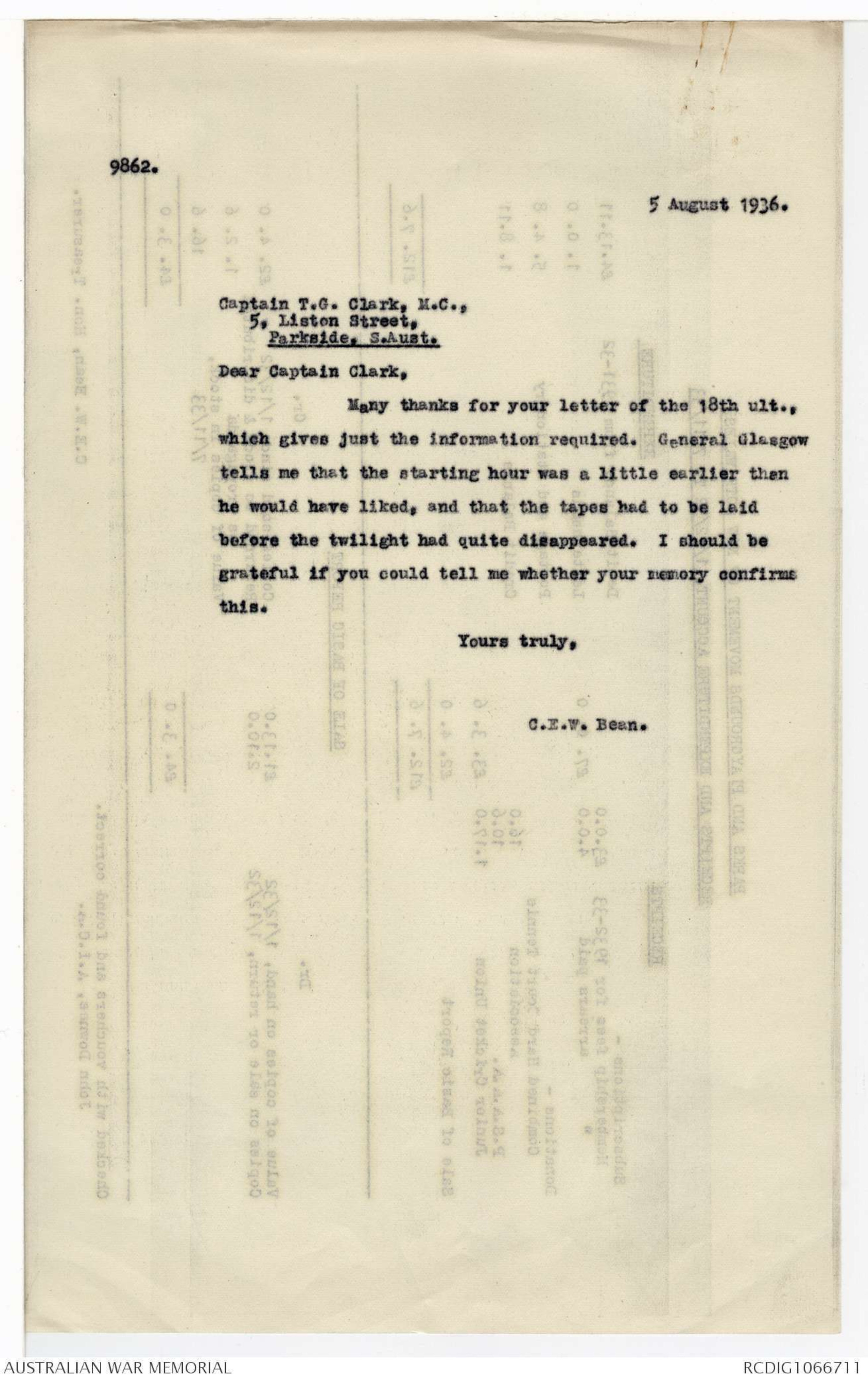
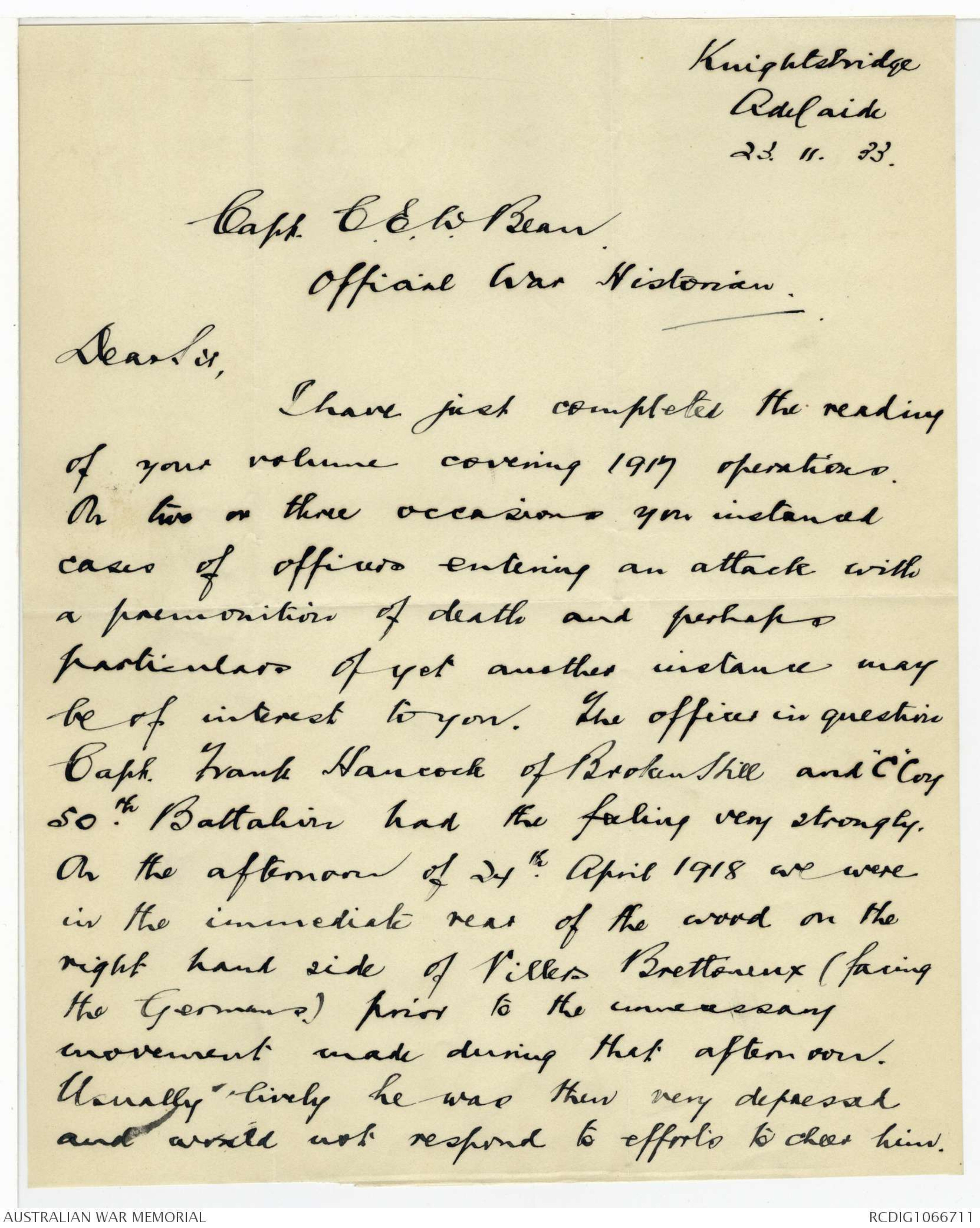
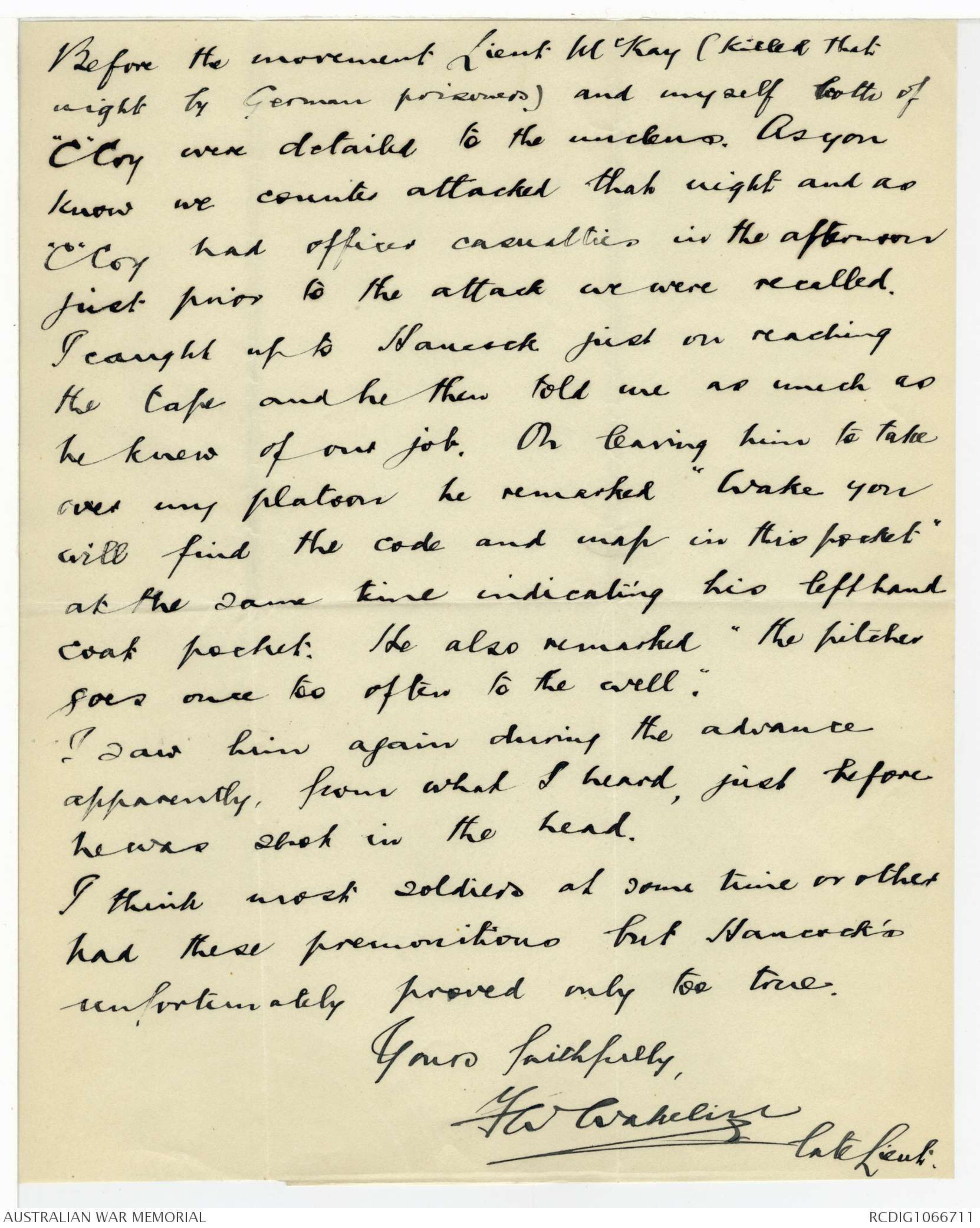
6
attack was over. Elliott agreed.
It was actually the 57th Bn
that ^thus cleared V/B. of the Germans.
Henniker had with him two
excellent Staff officers, one,
Armitage, a general staff man,
& the other on the "A" Staff. Henniker
himself did not seem to "take
hold", and his attitude towards the
Australian brigadiers was not
encouraging. He did not say a
word of appreciation to them after
the operation. But the two staff
officers did - they rode over,
and Armitage, in saying what agood stunt satisfactory operation they thought it was, added xx in an aside to Glasgow
that he was glad that Glas he hadtackled handled "the old man" in the way he
had done - it was the way to get the task through.
9511.
2 December 1935.
My dear Glasgow,
In finishing off the chapter dealing with
Villers-Bretonneux, April 24-25 1918, I am puzzled by the
fact that, whereas you gave your men the objective set by
corps headquarters, beyond the Monument and aerodrome,
Elliott had made his objective the Villers-Bretonneux--Hamel
road and an extension of it southwards, 1,000 yards behind the
left of your objective. As you were present at his conference
with his battalion commanders about 7-30-8 p.m., I am wondering
whether this discrepancy was noticed at the time and
whether anything was said about it. So far as I can see,
Elliott did not order his troops to reach the old British
front line, but a line 1,000 yards west of it; and, if you
had reached your objective, the process of joining might have
been difficult.
Would you give me your recollection of this? I
have concluded that the discrepancy was not noticed at the
time.
With kind regards
Yours sincerely,
C E W Bean
Major-General Hon. Sir William Glasgow, K.G.B.,
C.M.G., D.S.O, V.D,
Grange Hill
Gregory Terrace,
Brisbane Q'land.
THE PARKS AND PLAYGROUNDS MOVEMENT OF NEW SOUTH WALES.
CONSTITUTION.
(1) The title of the organisation shall be "The Parks and
Playgrounds Movement of New South Wales."
(2) The objects are:-
(a) to secure the systematic and timely reservation
of adequate park and playground space in N.S.Wales;
(b) to ensure the appropriate and effective use and
control of all park and playground spaces;
(c) to these ends, to secure unity of effort among all
bodies interested.
(3) The Movement shall be governed by a General Council
consisting of delegates from associated bodies, forming a Combined
Committee. Each associated body may send two delegates, duly
accredited by its association. Except as hereinafter laid down,
each delegate shall exercise only one vote.
(4) Additional bodies may be admitted to the Movement upon
approval by the Executive Committee.
(5) The officers shall be:-
(a) president and three vice-presidents, each of the
following sections being represented - (i) men’s sports,
(ii) women’s Sports, (iii) town planning bodies,
(iv) scientific, conservation, and historical bodies;
(b) honorary secretary and honorary treasurer.
Proceedings between general meetings shall be governed by
an Executive Committee of eight members, comprising two representatives
of each of the following sections - (i) men's sports, (ii) women's
sports, (iii) town planning bodies, (iv) scientific, conservation, and
historical bodies. These eight shall include the President and
Hon. Secretary & Hon. Treasurer. The Executive Committee may co-opt
any other members in an advisory capacity only.
(6) A membership fee, minimum 5/-, shall be payable annually
by each associated body.
(7) The Combined Committee shall meet annually for election
of officers, consideration of the year's work and finance, or any
other matters relating to the objects of the Movement; it may also
meet from time to time when called together by the Executive Committee.
The Executive Committee shall meet on the request of the Chairman;
or of the Hon. Secretary, or of any two members.
(8) At meetings of the Combined Committee separate votes may,
where the Chairman so decides, be taken among representatives of
each of the following sections: (i) men’s sports, (ii) women’s sports,
(iii) town planning bodies, (iv) scientific, conservation, and
historical bodies. As to the section to which each representative
belongs, and as to the right of any representative to vote in more
than one section, the decision of the Chairman shall be final.
(9) Rules may be amended, cancelled, or added to either at an
annual meeting or a special general meeting of the Combined Committee
convened for that purpose of which a fortnight’s notice has been given.
(10) Delegates shall hold office for a year unless the bodies
electing them decide otherwise. Notices of meetings shall be sent to
delegates through the Secretary of the body which they represent.
(11) All officers and the Executive Committee shall be elected
annually.
Chap XVl p105.
QUEENSLAND CLUB
BRISBANE
9: Xll: 35
My dear Bean
My recollection of the
Villers-Bretonneux counter attack,
with reference to the point you raise
are as follows.
I did not see Elliott on 24th April
1918 until about 8 pm. My orders,
based on those of the Division, had
been issued some time before &
Elliott had just finished a conference
with his Bn Commanders. He told
me that he had given instructions
for a Bn to move around the Western
side of V-B then up a gully on
the southern side of V.B, joining
up with the left of my advance. I
pointed out to him that this Bn
would be moving across the
advance of the 2 British Bns which
were to attack the town from the North
West & South West. He then cancelled
the instruction for the Bn mentioned.
We did not discuss the objective
of the attack. I naturally thought
QUEENSLAND CLUB
BRISBANE
that his objective would be like mine
that of the Divn.
The fact that his troops did not
attempt to get as far as mine
may explain why my men were
not able to maintain the position
they reached & had to fall back ^a little.
In the morning I think my left
was nearly south of Elliotts right,
As for as I am concerned the
discrepancy was not mentioned nor
was it noticed.
Kind regard
Yours Sincerely
J. W. Glasgow
TELEPHONE: FL 4I56.
Commonwealth of Australia
HISTORIAN,
VICTORIA BARRACKS,
PADDINGTON, N.S.WALES.
No. 9820.
8 July 1936.
Captain T.G. Clark, M.C.,
5, Liston Street,
Parkside, S.Aust.
Dear Captain Clark,
Writing in January last, you kindly offered to
help me on points concerning Villers-Bretonneux, 25 April
1918. I should be grateful if you could tell me -
(1) precisely where the left flank of the jumping
-off tape rested; and
(2) whether there was any firing from the Germans in the wood
immediately before the attack started.
Yours faithfully,
C. E. W. Bean.
C. E. W. Bean.
Official Historian.
Diagram - see original document
No. 9820.
(1) Alter sketches so as to
show tape line clear of
horn of wood.
(2) Was it twilight?
5 Liston Street,
Parkside.
18th July, 1936.
Official Historian,
Victoria Barracks
PADDINGTON.
Dear Sir,
In reply to your letter of the 8th July, 1936
re information of an attack which took place at Villers-
Bretonneux on 25th April, 1918.
In reply to your first query, I should like to
mention that the left flank of the jumping-off tape rested on
the corner of the wood (Bois d'Aquenne), which by the way made
an abrupt corner of approximately ninety degrees the map reference
of which is (U.3.a.5.7.). The southern side of the wood
was shaped more as shown by my red lines on your letter, which
I return herewith, and gave a clear run for the troops towards
their objective.
In regards the second point, there was definitely
some machine gun fire coming from the wood in question, and
it was necessary for the intelligence officer of the unit on
the left flank to clear the corner of the wood (U.3.a.5.7.)
of a machine gun before he could get his section of the jumping-
off tape down.
Too much credit cannot be given to the intelligence
officers, and their men, who laid this jumping-off tape
down under my supervision, as they were operating in the dark
in country which they had never seen before.
If I can be of any further assistance to you
on this matter, I will be glad to do so to the best of my
ability.
Yours sincerely,
T. G. Clark
9862.
5 August 1936.
Captain T.G. Clark, M.C.,
5, Liston Street,
Parkside, S.Aust.
Dear Captain Clark,
Many thanks for your letter of the 18th ult.,
which gives just the information required. General Glasgow
tells me that the starting hour was a little earlier than
he would have liked, and that the tapes had to be laid
before the twilight had quits disappeared. I should be
grateful if you could tell me whether your memory confirms
this.
Yours truly,
C.E.W. Bean.
Knightsbridge
Adelaide
23. 11. 33
Capt. C.E.W. Bean
Official War Historian
Dear Sir,
I have just completed the reading
of your volume covering 1917 operations.
On two or three occasions you instanced
cases of officers entering an attack with
a premonition of death and perhaps
particulars of yet another instance may
be of interest to you. The officer in question
Capt Frank Hancock of Broken Hill and "C" Coy
50th Battalion had the feeling very strongly.
On the afternoon of 24th April 1918 we were
in the immediate rear of the wood on the
right hand side of Villers Bretonneux (facing
the Germans) prior to the unnecessary
movement made during that afternoon.
Usually lively he was then very depressed
and would not respond to efforts to cheer him.
Before the movement Lieut McKay (killed that
night by German prisoners) and myself both of
"C" Coy were detailed to the nucleus. As you
know we counter attacked that night and as
"C" Coy had officer casualties in the afternoon
just prior to the attack we were recalled.
I caught up to Hancock just on reaching
the tape and he then told me as much as
he knew of our job. On leaving him to take
over my platoon he remarked "Wake you
will find the code and map in this pocket"
at the same time indicating his left hand
coat pocket. He also remarked "the pitcher
goes once too often to the well."
I saw him again during the advance
apparently, from what I heard, just before
he was shot in the head.
I think most soldiers at some time or other
had these premonitions but Hancock's
unfortunately proved only too true
Yours faithfully
F W Wakelin
late Lieut.
 Sam scott
Sam scottThis transcription item is now locked to you for editing. To release the lock either Save your changes or Cancel.
This lock will be automatically released after 60 minutes of inactivity.